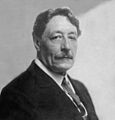Reginald Bathurst Birch facts for kids
Quick facts for kids
Reginald Bathurst Birch
|
|
|---|---|

Reginald Bathurst Birch.
|
|
| Born |
Reginald Bathurst Birch
May 2, 1856 London, England
|
| Died | June 17, 1943 (aged 87) The Bronx, New York
|
| Nationality | American |
| Education | Toby E. Rosenthal, Royal Academy, Munich |
| Known for | Illustration |
Reginald Bathurst Birch (born May 2, 1856 – died June 17, 1943) was a talented artist and illustrator. He was born in England but later became an American citizen.
Birch is most famous for his drawings in the 1886 book Little Lord Fauntleroy by Frances Hodgson Burnett. His pictures of the main character, Cedric, made a big splash. They even started a new fashion trend for young boys! Besides his well-known illustrations, Birch was also a skilled painter of people and landscapes.
Contents
About Reginald Birch's Life
Early Years and Family
Reginald Bathurst Birch was born in London, England, on May 2, 1856. His father, William Alexander Birch, was an officer in the British army. His mother was Isabella Birch.
When he was a child, Reginald lived for a while with his grandfather. This was on the Isle of Jersey, while his father was serving in India.
In 1870, when Reginald was 14, he moved to San Francisco, California with his parents. Later, he became a citizen of the United States.
Reginald Birch was married two times. He had two children: a son and a daughter. His son, Rodney Bathurst Birch, grew up to be an early film actor.
Reginald Birch passed away at 87 years old. He died from heart failure in the Bronx, New York. He was buried at Woodlawn Cemetery in New York.
Reginald Birch's Art Career
How He Started in Art
Reginald Birch's artistic skills first became clear in San Francisco. He helped his father create large wood-block posters for plays.
Soon, a painter named Toby Edward Rosenthal noticed his talent. Rosenthal became a mentor to Birch. He let Birch use his art studio and helped him get more art training.
From 1873 to 1881, Birch traveled and studied in Europe. He attended the Royal Academy in Munich, Germany. He also drew pictures for different books and magazines in cities like Vienna, Paris, and Rome.
Becoming a Famous Illustrator
When Birch returned to the United States, he settled in New York City. There, he became a popular magazine illustrator. His artwork appeared in famous magazines such as St. Nicholas, The Century, Harper's, Life, and The Youth's Companion. He also helped start the Society of Illustrators in New York.
His biggest success came in 1886 with the children's book Little Lord Fauntleroy. Birch's illustrations showed the young hero with long, curly hair and a fancy velvet suit. Many mothers copied this style for their own sons. Because of this, Birch's name was always linked to the character, which sometimes annoyed him!
During this popular time, Birch illustrated over 40 books. Many of these stories and drawings first appeared in magazines. He also illustrated more of Frances Hodgson Burnett's books, like Sara Crewe (1888).
Later Career and Comeback
After 1914, the demand for Birch's artwork slowed down. By the 1930s, he was not doing well financially.
However, his career got a boost in 1933. This happened when he illustrated Louis Untermeyer's book The Last Pirate. After that, he illustrated about 20 more books. He stopped working around 1941 because his eyesight began to fail.
In 1939, a special collection of his work was published. It was called Reginald Birch—His Book. It featured stories and poems with his original illustrations from 1886 to 1938.
Images for kids


